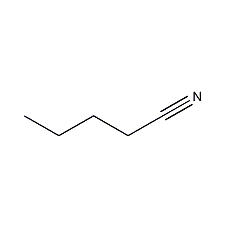Valeronitrile Valeronitrile

Structural formula
| Business number | 031J |
|---|---|
| Molecular formula | C5H9N |
| Molecular weight | 83.13 |
| label |
1-cyanobutane, n-valeronitrile, Butyl cyanide, butane cyanide, n-Butyl cyanide, Butylcarbonitrile, Butyl cyanide, Pentane nitrile, 1-Cyanobutane, Extracting agent, Nitrogen-containing compound solvents, straight chain compounds, synthetic raw materials, Intermediates |
Numbering system
CAS number:110-59-8
MDL number:MFCD00001974
EINECS number:203-781-8
RTECS number:YV8195000
BRN number:1736706
PubChem number:24869532
Physical property data
1. Properties: colorless liquid[1]
2. Melting point (℃): -96.2[2]
3. Boiling point (℃): 141.3[3]
4. Relative density (water=1): 0.795[4]
5. Saturated vapor pressure (kPa): 1.33 (30℃)[5]
6. Heat of combustion (kJ/mol): -3229.1[6]
7. Critical pressure (MPa): 3.26[7]
8. Octanol/water partition coefficient : 1.12[8]
9. Flash point (℃): 28[9]
10. Explosion limit ( %): 9.6[10]
11. Lower explosion limit (%): 1.5[11]
12. Dissolution Properties: Insoluble in water, soluble in ethanol and ether. [12]
Toxicological data
1. Acute toxicity: oral LD50 in mice: 191mg/kg; subcutaneous injection LD50 in mice: 524.61mg/kg.
2. Other multiple dose toxicity: Oral TDLo in small rats: 525mg/kg/3D-I
3. Acute toxicity [13]
sup> LD50: 191mg/kg (mouse oral)
Ecological data
1. Ecotoxicity No data available
2. Biodegradability No data available
3 .Non-biodegradability No information available
4. Other harmful effects[14] This substance is harmful to the environment and should be specially Pay attention to water pollution.
Molecular structure data
1. Molar refractive index: 25.12
2. Molar volume (cm3/mol): 104.4
3. Isotonic specific volume (90.2K ): 239.3
4. Surface tension (dyne/cm): 27.5
5. Polarizability (10-24cm3): 9.96
Compute chemical data
1. Reference value for hydrophobic parameter calculation (XlogP): None
2. Number of hydrogen bond donors�:0
3. Number of hydrogen bond acceptors: 1
4. Number of rotatable chemical bonds: 2
5. Number of tautomers: None
6. Topological molecule polar surface area 23.8
7. Number of heavy atoms: 6
8. Surface charge: 0
9. Complexity: 57.6
10. Number of isotope atoms: 0
11. Determine the number of atomic stereocenters: 0
12. Uncertain atomic stereocenter Number of stereocenters: 0
13. Determine the number of stereocenters of chemical bonds: 0
14. Uncertain number of stereocenters of chemical bonds: 0
15. Total Number of price key units: 1
Properties and stability
1. Stability[15] Stable
2. Incompatible materials[16] Strong oxidants, strong reducing agents, strong acids
3. Conditions to avoid contact[17 ] Heating
4. Polymerization hazard[18] No polymerization
5. Decomposition products[19] Cyanide
Storage method
Storage Precautions[20] Store in a cool, ventilated warehouse. Keep away from fire and heat sources. Keep container tightly sealed. They should be stored separately from oxidants, reducing agents, acids, and food chemicals, and avoid mixed storage. Use explosion-proof lighting and ventilation facilities. It is prohibited to use mechanical equipment and tools that are prone to sparks. The storage area should be equipped with emergency release equipment and suitable containment materials.
Synthesis method
Prepared from butyl bromide and sodium cyanide. Add water to the sodium cyanide and heat it to dissolve in a water bath, then add a certain amount of 95% industrial ethanol and butane bromide to reflux for 25-30 hours, cool to room temperature, filter out the sodium bromide, and fractionate the filtrate with a high-efficiency fractionation column. The alcohol is evaporated at 78-85°C, and the 85-140°C fraction is collected and treated with ammonium chloride to separate it into two layers. The upper liquid is taken for fractionation again, and the 138-141°C fraction is collected as the finished product. ![]()
Purpose
Used as an intermediate in organic synthesis. [21]